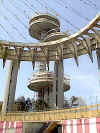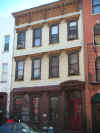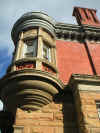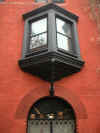brooklyn and the boroughs

|
 |
 |

|
| 001 Jones Beach | 002 TWA Terminal JFK Airport | 003 New York State Pavilion | 004 Bronx Zoo |
|
See also the Brooklyn sections |
|||
 |
 |

|
 |
| Greenpoint | Williamsburg | Bedford- Stuyvesant | Park Slope |
|
The borough of Brooklyn comprises the territory of Kings County. Until almost a century ago Kings County was least among the three original counties of Long Island, not only in area, but also in population. The increase was slow outside the limits of the two later cities of Williamsburgh and Brooklyn. A description of the other towns within the county in the year 1700 closely fits the state of things in 1800. In 1700 the land was nearly all under cultivation; a century later some of the farms had been divided and the number of inhabitants had increased. During the first four decades of the nineteenth century the population rose more rapidly - from 5,740 in 1800, to 47,613 in 1840, yet this increase was mainly caused by the influx of people into Brooklyn and Williamsburgh, where ropewalks and factories had been built. The other towns were still farming districts. Indian footpaths connected the shores of the East River and Jamaica Bay. They followed the line of least resistance through the flats or level lands, which had been the cornfields of the Indians for many years, and these flats the white men were eager to possess. Along one trail settlements were established which were known as The Ferry, Breukelen, Bedford, Midwout, and Nieuw Amersfoort. Along another trail the Boswijck and "het kruispad" settlements came into existence. At an early date several settlers bought lands from the Indians in Flatlands, Flatbush, and probably in Brooklyn. When the riding were
created, Gravesend was made the shire town of the West Riding. This
community had been founded by Englishmen, and was the only town in the
later Kings County with which the English government could transact
official business in English speech. The other settlements carried on
their legal affairs in the Dutch tongue. Breukelen, which was then named
Brookland; Midwout, then called Flatbush; Nieuw Amersfoort, later called
Flatlands; Boswijck and New Utrecht were therefore made a separate
district under the appellation of the "Five Dutch The Five Dutch Towns also
constituted an ecclesiastical society, and joined in the support of
their ministers until the collegiate system was abolished about the end
of the eighteenth century. In 1840 the town of Williamsburgh was
separated from Bushwick and on January 1, 1852, the city of
Williamsburgh came into existence. In 1852 the town of New Lots was
separated from Flatbush. On January 1, 1855, the cities of
Brooklyn and Williamsburgh and the town of Bushwick were consolidated
and incorporated as the city of Brooklyn. In 1886 the town of New Lots
was annexed to this union, followed in 1894 by the towns of Flatbush,
Flatlands, New Utrecht, and Gravesend. On January 1, 1898, Brooklyn
became a borough of the city of New York. In 1810 Brooklyn had a The postoffice of Kings
County was in this town, and was a principal point of concentration for
all the stage and other roads on the island. There was one weekly
newspaper. A drawbridge was at this time contemplated to connect
Brooklyn with New York. In 1850 the population of Brooklyn had risen to
96,838. In 1810 the village of New Utrecht contained forty houses and
the Reformed Dutch Church edifice. The taxable property was valued at
$275,765; the population was then 907; in 1835, 1,027; in 1840, 1,283.
Neighborhoods in this town were Bay Ridge, Fort Hamilton, and Bath on
Gravesend Bay. The fortress known as Fort Hamilton was constructed
during the years 1824-1832. Fort Lafayette was built upon Hendrick's
Bluff, 200 yards from the shore, in 1812, and was originally known as
Fort Diamond. A few feet below the surface, at the Narrows, was found in
1837 more than Of the 7,000 acres of land in the original Gravesend, 3,500 were farm land, 300 woodland, and the balance salt meadows and a ridge of sandhills near the seashore. Directly opposite Gravesend, on the other side of Lower New York Bay, are the Navesink Highlands; along these highlands and the Navesink River the sand is of a reddish color, hence the name of Red Bank in the neighborhood. On the Long Island shore the sand is of a grayish color and this fact may have led the settlers to name the shore "Granuwezande" or Grauesand, as the name is often written in the old documents, i.e.,"Grayishsand." The Dutch Church was organized in 1763 and a church edifice was erected, which was replaced by a second one in 1833, and this one again by a third in 1894. Shortly after the conquest the town was made the seat of justice, a courthouse was erected, and the Courts of Session of the West Riding were held there. In 1810 Gravesend village contained twenty houses, the Reformed Dutch Church and a schoolhouse. A lighthouse was designed to be erected at Coney Island. There were two tidemills. The taxable property was valued at $178,477. The population was 520, which rose to 810 in 1840. The settlement in Sheepshead Bay was originally known as "The Cove" and later as Sheepshead Bay. Other neighborhoods were Unionville and Guntherville, on Gravesend Bay, South Greenfield on the King's Highway, and on the head of Gerrettsen's Creek, extending over the Flatlands line. Flatbush was originally
known as Midwout and was first settled in 1651. In 1810 it was known as
the capital of the county. The village then contained about 100 houses,
standing on the town road and covering a stretch one and a half miles in
length; the stone buildings of the Reformed Dutch Church, the
courthouse and jail, Erasmus Hall Academy and two common schools, also
two tidemills and Flushing was originally called Vlissingen, after a place in the Netherlands. The settlers erected a blockhouse near the pond at a point later known as Union Street and Broadway. Prior to 1821 the only road between Little Neck and Flushing Village was through what was later known as the "alley," winding its way round about and over hills and increasing the distance more than two miles before reaching its terminus at the "lonely barn." In 1824 the road from Little Neck Hotel was donated, a causeway constructed, and a ridge built at Wynandt Van Zandt's expense, who owned the land. In 1824 the road was turnpiked to Roslyn and three years later to Oyster Bay. It was known as theFlushing and North Hempstead Turnpike Road and later as Broadway. An Indian trail formerly existed there and in widening the road the Indian burying ground at Little Neck, where for two centuries the remains of the red men had rested, had to be cut off. The Jamaica band of Indians dwelt upon the shores of Rockaway Inlet; the territory around Jamaica Bay was known as Conorasset, i. e., the planting land of the bears, or Canarsee tribe. When Queens County was created the courts were transferred from Hempstead to Jamaica Village and a County Court was erected. When the building became too small for its purposes and the stone meeting house had been erected, the courts were held for some years in that edifice. Later a new courthouse was erected and used until the seat of justice was removed to North Hempstead. Increase Carpenter's Tavern, later known as Goetze's Hotel, was used as a tavern from the date of 1710. The inn was the scene of General Woodhull's capture. The property purchased by Rufus King, in 1805, consisted of a roomy house and of about ninety acres of land, situated a little west of the village on the main road. The town was several times the seat of the colonial legislatures.
|
|||
|
In 1646, the Village of
Breuckelen was authorized by the Dutch West India Company and became the
first municipality in what is now New York State (the predecessors of
the Cities of Albany and New York were numbers two and three,
respectively).
In 1683, almost 20 years after the English kicked out the Dutch (1664), the General Assembly of Freeholders reorganized the governmental structure in all of the province of New York into 12 counties, each of which was sub-divided into towns. Brooklyn was one of the original six towns of Kings County, an original county when the county/town system was established in 1683. (Other local area original counties were New York, Richmond, Queens, Westchester and Suffolk. The Bronx was part of Westchester County until 1873, when the western Bronx was annexed by New York City/County, and 1895, when the eastern Bronx was annexed as well. The eastern two-thirds of Queens County seceded and became Nassau County in 1899, making Nassau the youngest county in New York State, although the Bronx "paper" county was established in 1914 when the Bronx "seceded" from New York County.)
The Town of Brooklyn did not have that large a population in 1790, the year of the first federal census. The Town of Oyster Bay, then in Queens County, had a larger population than did Brooklyn that year. The Village of Breuckelen (1646) preceded City of Nieuw Amsterdam (1653) by some 7 years. Brooklyn/Kings County has 2 names because it took some 200 years for Brooklyn to annex the other parts of Kings County. When the City of Brooklyn annexed the City of Williamsburgh and the Town of Bushwick, this area was then known as the eastern district of the City of Brooklyn and Williamsburgh lost its final "h". The streets in Brooklyn do not line up because each of the 2 cities and 6 towns in Kings County were independent municipalities and purposely decided to create street grids with different naming systems that did not line up with the adjoining city or town. The Town of Gravesend was the only town where the streets run long north-to-south, all other cities and towns ran their streets long west-to-east. Gravesend was the only English town, all the others were Dutch. South Brooklyn is north of southern Brooklyn because until 1894 the Red Hook area (South Brooklyn) was the southernmost part of the City of Brooklyn. Bay Ridge was originally called "Yellow Hook" until a yellow fever epidemic struck and the name was changed. Suggested reading: The Brooklyn Almanac by Margaret Latimer is a history of Kings County/City of Brooklyn/Borough of Brooklyn. Some problems with geography, but a good resource. Ms. Latimer also wrote Two Cities that describes month-by-month life in New York City (Manhattan and the western Bronx) and in the City of Brooklyn (the northern-third of Kings County) in 1883, the year the Brooklyn bridge was built.
Key Dates in the History of Kings County (Brooklyn) 1646 Village of Breuckelen granted charter by the Dutch West India Company. 1683 Kings County and 6 towns created: Brooklyn, Bushwick, Flatbush, Flatlands, Gravesend and New Utrecht. 1816 Village of Brooklyn incorporated within Town of Brooklyn. 1827 Village of Williamsburgh incorporated within Town of Bushwick. 1834 Town of Brooklyn (including Village of Brooklyn) becomes City of Brooklyn. Kings County now includes 1 city (Brooklyn) and 5 towns (Bushwick, Flatbush, Flatlands, Gravesend and New Utrecht). 1851 Village of Williamsburgh secedes from Town of Bushwick and becomes City of Williamsburgh. Kings County now includes 2 cities (Brooklyn and Williamsburgh) and 5 towns (Bushwick, Flatbush, Flatlands, Gravesend and New Utrecht). 1852 Town of New Lots secedes from Town of Flatbush. Kings County consists of 2 cities (Brooklyn and Williamsburgh) and 6 towns (Bushwick, Flatbush, Flatlands, Gravesend, New Lots and New Utrecht). 1854 City of Williamsburgh and Town of Bushwick consolidated into City of Brooklyn. Kings County now 1 city (Brooklyn) and 5 towns (Flatbush, Flatlands, Gravesend, New Lots and New Utrecht). 1886 Town of New Lots annexed into City of Brooklyn. Kings County now 1 city (Brooklyn) and 4 towns (Flatbush, Flatlands, Gravesend and New Utrecht). 1894 Towns of Flatbush, Gravesend and New Utrecht annexed into City of Brooklyn. Kings County now 1 city (Brooklyn) and 1 town (Flatlands). 1896 Town of Flatlands annexed into City of Brooklyn. Kings County and City of Brooklyn become coterminous. |
|||
|
Timeline by Decade 1834: City of Brooklyn (former Town of Brooklyn) incorporated 1838: Green-Wood Cemetery incorporated 1839: Brooklyn city plan adopted; street grid mapped -------------------------------------------------------------------------------- 1840s-1850s: First great wave of European immigration begins around mid-century, largely northern and western Europeans 1847: Atlantic Basin completed 1849: Brooklyn City (now Brooklyn Borough) Hall completed -------------------------------------------------------------------------------- 1851: City of Williamsburgh chartered 1852: Town of New Lots, formerly part of the Town of Flatbush, organized 1855: Consolidated City of Brooklyn established, merging former City of Brooklyn with City of Williamsburgh and Town of Bushwick 1855: 47 percent of Brooklyn's population is foreign-born (compared to 51 percent of Manhattan's) Of the foreign born population, the Irish comprised 55%. 1858: National Association of Base Ball Players (NABBP), baseball's first centralized organization, formed by delegates from New York and Brooklyn; 71 teams in Brooklyn -------------------------------------------------------------------------------- 1860: Brooklyn is third-largest U.S. city, with a population of almost 267,000 1861: U.S. Civil War begins 1863: The Brooklyn Historical Society founded as The Long island Historical Society in Brooklyn Heights; New York City draft riots break out and violence spreads to Brooklyn 1864: Brooklyn Long Island Sanitary Fair held at new Brooklyn Academy of Music to raise money for wives and children of impoverished Civil War draftees -------------------------------------------------------------------------------- 1874: Prospect Park completed; street grids mapped for Towns of Flatbush, Flatlands, New Utrecht, and Gravesend Currier and Ives - City of Brooklyn, 1879 (note that bridge is pictured as completed) -------------------------------------------------------------------------------- 1880s: Second great wave of European immigration lasts into early twentieth century, largely eastern and southern Europeans 1880: Brooklyn is fourth largest producer of manufactured goods in nation 1881: The Brooklyn Historical Society opens new building on Pierrepont Street in Brooklyn Heights, still its home today 1882: Chinese Exclusion Act; repealed in 1943 1883: Brooklyn Bridge completed; Dodgers organized as minor league team in Brooklyn 1886: Town of New Lots annexed to Brooklyn -------------------------------------------------------------------------------- 1894: Towns of Flatbush, Gravesend, and New Utrecht annexed to the City of Brooklyn: 1896: Town of Flatlands annexed to the City of Brooklyn 1897: Brooklyn Public Library formed: Steeplechase Park opens in Coney Island 1898: City of Brooklyn (Kings County) consolidated into Greater New York -------------------------------------------------------------------------------- 1900: Brooklyn numbers 1,166,582 people 1902: Bush Terminal erects new buildings 1903: Williamsburg Bridge opens; Luna Park opens in Coney Island 1904: Dreamland opens in Coney Island Borough Hall Station. Picture of first train run through tube which is 90 feet below the East River. (Early Postcard) 1908: The IRT, New York's first subway, connected to Brooklyn via the Joralemon Street tunnel Start of Brooklyn Marathon 1909 1909: Manhattan Bridge opens -------------------------------------------------------------------------------- Brooklyn Baseball Club - 1911 1911: Triangle Shirtwaist Company fire in NYC kills 140 young workers 1913: Ebbets Field, home to the Brooklyn Dodgers, opens 1915: Brooklyn Navy Yard builds Arizona, New Mexico, and other battleships 1915: 'Great Migration" of African Americans from America's rural South, continues through 1930s and is followed by renewed migration from the South during and after World War II 1917: United States gives citizenship to Puerto Ricans; beginning of large migration to Brooklyn and New York area 1919: Brooklyn Army Terminal completed -------------------------------------------------------------------------------- 1920: Subway arrives at Coney Island. Prohibition starts. 1924:Immigration Act of 1924; United States enacts restrictive legislation, aimed largely at southern and eastern Europeans, which sharply reduces immigration for next forty years -------------------------------------------------------------------------------- 1930: Brooklyn is New York City's most populous borough, population 2,560,401. 1933: Prohibition Repealed. 1936: IND (Independent) subway opens in Brooklyn -------------------------------------------------------------------------------- 1941: Attack on U.S. naval base at Pearl Harbor triggers U.S. entry into World War II 1942: Iowa launched in record time at Brooklyn Navy Yard; U.S. Navy transforms Floyd Bennett Field, New York City's first airport, into naval air training station 1945: WWII is over. 1947: Jackie Robinson joins the Dodgers as the first African American player in the major leagues 1950: Brooklyn's population peaks at 2,738,175 1954: Ellis Island closes 1955: Brooklyn Dodgers win World Series against longtime rival New York Yankees. Brooklyn Eagle folds after 114 year run 1957: Dodgers play their last game at Ebbets Field; leave for Califomia and become L.A. Dodgers -------------------------------------------------------------------------------- 1964: Verrazano Narrows Bridge completed, the longest suspension bridge in the world 1965: U.S. immigration laws ease; new immigrants mainly of Caribbean, Latin American, and Asian origin 1966: Brooklyn Navy Yard closes; in early 1970s City of New York and local nonprofit groups begin to transform into an industrial park. Brooklyn Heights designated New York’s first historic district 1969: West Indian/American Day Carnival parades along Brooklyn's Eastern Parkway for the first time; for many years had been held in Harlem -------------------------------------------------------------------------------- 1970: Brooklyn Army Terminal, a military ocean-supply facility is deactivated 1976: Nation’s Bicentennial celebrated 1977: Fulton Mall built in downtown Brooklyn -------------------------------------------------------------------------------- 1983: Centennial of Brooklyn Bridge celebrated -------------------------------------------------------------------------------- 1990: Brooklyn remains New York City's most populous borough; population of 2,300,664 the equivalent of the fourth-largest city in the nation after New York City, Los Angeles, and Chicago. Ellis Island Immigration Museum opens. 1995: World Series banner won by Brooklyn Dodgers in 1955 is donated to The Brooklyn Historical Society by the L.A. Dodgers |
|||